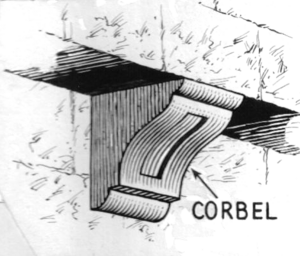Corbel facts for kids
Have you ever noticed a cool-looking stone or wood piece sticking out from a building's wall? That's probably a corbel! In architecture, a corbel is a strong piece of stone, wood, or metal that comes out from a wall. Its main job is to hold up something heavy above it, like a balcony or a roof. Think of it as a sturdy arm reaching out from the wall to give support.
Corbels are a type of bracket. A key difference is that a corbel is usually a solid part of the wall itself. A "console," on the other hand, is a piece that is added onto the wall's surface. In the United Kingdom, similar wooden pieces were sometimes called "tassels" or "braggers."
The idea of using corbels is very old. People have been using a building method called "corbelling" since the Neolithic period, also known as the New Stone Age. This technique involves stacking rows of corbels, each sticking out a little further than the one below it. This creates a strong support for a wall or a parapet (a low wall along the edge of a roof).
What Does "Corbel" Mean?
The word "corbel" comes from an old French word. It actually comes from the Latin word corbellus, which means "little raven." This name was given because a corbel often looks a bit like a raven's beak sticking out from a wall. In French, a load-bearing corbel inside a building is still called a corbeau, which means "crow."
Images for kids
-
Corbels quarried for London Bridge but unused; Swell Tor quarry, Dartmoor
-
Corbelled arch at the Royal Palace of Ugarit, 2nd millennium BC
-
Corbelling to resemble machicolations on an 18th-century folly, Broadway Tower, England
See also
 In Spanish: Ménsula para niños
In Spanish: Ménsula para niños





